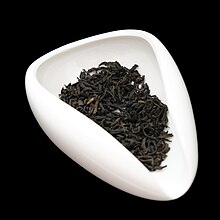
Back Lapsang Souchong Breton Lapsang Soutxong Catalan Lapsang souchong Czech Lapsang Souchong German Lapsang souchong Spanish Lapsang souchong Finnish Lapsang souchong French תה לפסנג סושונג HE Lapsang souchong Hungarian Lapsang souchong Icelandic
| Lapsang souchong | |||||||||||||||
|---|---|---|---|---|---|---|---|---|---|---|---|---|---|---|---|
 | |||||||||||||||
| Type | Black | ||||||||||||||
| Origin | Fujian Province, China | ||||||||||||||
| Quick description | Black tea that is smoke-dried | ||||||||||||||
| Temperature | 95 °C (203 °F) | ||||||||||||||
| Time | 2–3 minutes | ||||||||||||||
| Chinese name | |||||||||||||||
| Traditional Chinese | 正山小種 | ||||||||||||||
| Simplified Chinese | 正山小种 | ||||||||||||||
| Literal meaning | “Coarse tea leaves from the Upright Mountains” | ||||||||||||||
| |||||||||||||||
| Alternative Chinese name | |||||||||||||||
| Traditional Chinese | 立山小種 | ||||||||||||||
| Simplified Chinese | 立山小种 | ||||||||||||||
| Literal meaning | “Coarse tea leaves from Li Mountain” | ||||||||||||||
| |||||||||||||||

Lapsang souchong (/ˌlæpsæŋ ˈsuːtʃɒŋ/; Chinese: 立山小種) or Zhengshan xiaozhong (Chinese: 正山小種; pinyin: zhèngshān xiǎozhǒng, 'Proper Mountain Small Varietal') is a black tea consisting of Camellia sinensis leaves that may be smoke-dried over a pinewood fire. This smoking is accomplished either as a cold smoke of the raw leaves as they are processed or as a hot smoke of previously processed (withered and oxidized) leaves. The intensity of the smoke aroma can be varied by locating the leaves closer or farther (or higher or lower in a multi-level facility) from the source of heat and smoke or by adjusting the duration of the process. The flavour and aroma of smoked lapsang souchong is described as containing empyreumatic notes, including wood smoke, pine resin, smoked paprika, and dried longan; it may be mixed with milk but is not bitter and usually not sweetened with sugar. The tea originates from the Wuyi Mountains region of Fujian and is considered a Wuyi tea (or bohea). It is also produced in Taiwan. It has been labelled as smoked tea (熏茶), smoky souchong, tarry lapsang souchong and lapsang souchong crocodile. While the tea leaf grading system adopted the term souchong to refer to a particular leaf position, lapsang souchong may be made with any leaf of the Camellia sinensis plant,[citation needed] though it is not unusual for the lower leaves, which are larger and less flavourful, to be used as the smoking compensates for the lower flavour profile and the higher leaves are more valuable for use in unflavoured or unblended teas. In addition to its consumption as a tea, lapsang souchong is also used in stock for soups, stews and sauces or otherwise as a spice or seasoning.[1] Beginning in the early 21st century, an unsmoked variety of lapsang souchong was developed in the village of Tong Mu Guan in the Wuyi mountains. The unsmoked variety has become increasingly popular, particularly in the Chinese domestic market.[2]
- ^ Christensen, Emma. "Cooking with Tea: Smoky Lapsang Souchong". The Kitchn. Retrieved 6 January 2023.
- ^ "Lapsang Souchong: Smoked vs. Unsmoked". Comins Tea. Retrieved 6 January 2023.
© MMXXIII Rich X Search. We shall prevail. All rights reserved. Rich X Search